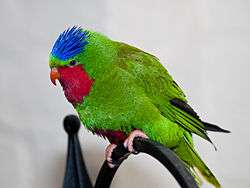Blue-crowned lorikeet
| Blue-crowned lorikeet | |
|---|---|
 | |
| Scientific classification | |
| Kingdom: | Animalia |
| Phylum: | Chordata |
| Class: | Aves |
| Order: | Psittaciformes |
| Superfamily: | Psittacoidea |
| Family: | Psittaculidae |
| Subfamily: | Loriinae |
| Tribe: | Loriini |
| Genus: | Vini |
| Species: | V. australis |
| Binomial name | |
| Vini australis (Gmelin, 1788) | |

The blue-crowned lorikeet (Vini australis) is a parrot found throughout the Samoa and Tonga islands and Lau archipelago, including: ʻAlofi, Fotuhaʻa, Fulago, Futuna, Haʻafeva, Niuafoʻou, Moce, Niuē, Ofu, Olosega, Sāmoa, Savaiʻi, Tafahi, Taʻu, Tofua, Tonga, Tungua, ʻUiha, ʻUpolu, Varoa, Vavaʻu, and Voleva. It is a 19 cm green lorikeet with a red throat, blue crown, and belly patch shading from red at the top to purple at the bottom.
It is still common, but declining on some islands, apparently from predation by rats. They frequent areas with flowering trees, including coconut plantations and gardens, usually in small flocks of less than about 15 individuals or in pairs during breeding season. It eats nectar, pollen, and soft fruits, especially wild hibiscus and coconut. The blue-crowned lory nests in holes in trees, but may also dig burrows in earth banks. Also known as:
- blue-crowned lory
- blue-crested lory
- Solomon lory
- Samoan lory
- Segavao, (Samoa)
- Henga, (Tonga)

References
- ↑ BirdLife International (2012). "Vini australis". IUCN Red List of Threatened Species. Version 2013.2. International Union for Conservation of Nature. Retrieved 26 November 2013.
- Juniper & Parr (1998) Parrots: A Guide to Parrots of the World; ISBN 0-300-07453-0.
- Forshaw (2006) Parrots of the World: An Identification Guide; ISBN 0-691-09251-6.
| ||||||||||||||||||||||||||||||||||||||||||||||||||||||
